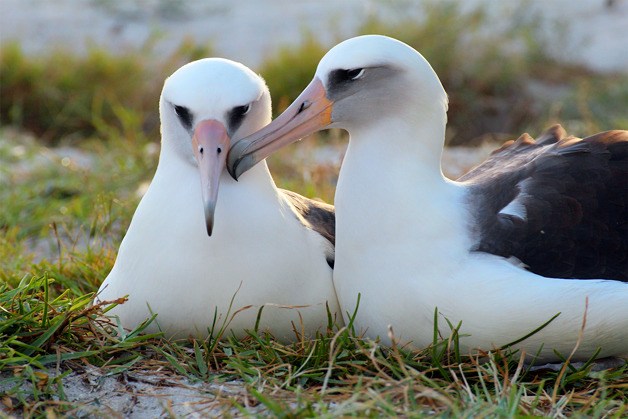Just as she has for over 60 years, she returned. Right on schedule!
Each fall around the beginning of December, I await word of the world’s most famous albatross, Wisdom. This year, on the day after Thanksgiving, the oldest known breeding bird was spotted at her nesting colony on Midway Atoll National Wildlife Refuge located near the western end of the Hawaiian Island chain.
I’m always delighted that her return coincides with our holiday season of hope and peace. It’s a reminder to me of how that magical spark of life survives in the darkest days and during a time of worldwide ecological upheaval.
We all expect that albatrosses are big birds, maybe like a gull on steroids. But even that didn’t prepare me for my first Laysan albatross sighting several years ago on Kauai. My husband and I were walking along a beach when we caught a glimpse of a bird flying toward us. With a wingspan of over six feet, it covered one-fourth mile in mere seconds and banked just over our heads, eyeing us and demanding we leave its breeding territory.
We exited quickly.
Soon after Wisdom returned to Midway, she began an elaborate mating ritual with her chosen partner. These black and white seabirds fling their heads straight up in a “sky call” then dip their heads up and down in unison, followed by loud clapping of their long pink beaks. Grunting and calling accompany the dance.
Laysan albatrosses produce one egg each year and spend six months rearing and feeding the chick. Wisdom appeared ready to produce another egg this breeding season, which she will incubate for over two months before a downy chick will peek out from under her protective wings.
Next June, Wisdom will depart the breeding colony, leaving us birders wondering if she can possibly survive to return another year.
These seagoing birds fly tremendous distances to collect food for their young and to disperse across the North Pacific ocean during the non-breeding season.
Wisdom has likely flown over 3 million miles. Do the math — that’s more than three round trip flights to the moon.
The typical life expectancy of a Laysan albatross is only half of Wisdom’s age, making it especially mind-boggling that she continues to produce young at the same age that humans are going on Medicare and collecting social security.
Wisdom was first banded at Midway in 1956. In the nearly 60 years since then, the worldwide albatross population has dropped 70 percent. This is partly due to commercial driftnet fishing that killed over 17,500 albatrosses in 1990.
Pollution also plays a role. The birds pick up plastics assuming they are bits of food. The plastics are ingested by the adult birds and also fed to the young, often with fatal consequences.
It is no surprise that 19 of the 21 albatross species are threatened with extinction. This makes Wisdom’s powerful story even more significant. She embodies the resiliency to give us hope that our planet can survive our neglect and denigration.
During this holiday season, may we all pledge to create clean, bird-friendly habitats right here on Whidbey, as well as in the larger earth community that we all cherish.
And may we remember this particular mother and chick for the hope they offer us to work tirelessly to heal and maintain our peaceful and healthy world.
Frances Wood can be reached at wood@whidbey.com.



